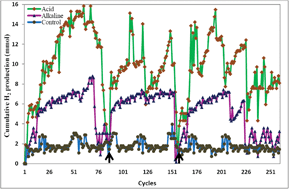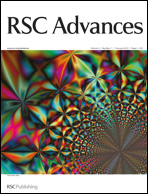Acidic and alkaline shock pretreatment to enrich acidogenic biohydrogen producing mixed culture: long term synergetic evaluation of microbial inventory, dehydrogenase activity and bio-electro kinetics†
Abstract
Comprehensive experiments were designed to evaluate the function of acid-shock (pH 3; orthophosphoric acid; 24 h) and alkaline-shock (pH 11; NaOH; 24 h) pretreatment methods for the selective enrichment of an acidogenic culture to enhance H2 production efficiency of mixed anaerobic consortia. Long term (520 days) operation in suspended-batch mode bioreactors illustrated the relative efficiency and feasibility of redox pretreated cultures against an untreated parent culture in enhancing H2 production. Relatively higher H2 production was observed with an acid pretreated mixed culture (15.78 mol kg−1 CODR) over alkaline pretreated (9.8 mol kg−1 CODR) and untreated mixed cultures (3.31 mol kg−1 CODR). On the contrary, substrate degradation was higher with untreated culture (ξCOD, 62.86%; substrate degradation rate (SDR), 1.10 kg CODR/m3-day) and alkaline-shock pretreated mixed culture (ξCOD, 59.93%; SDR, 1.22 kg CODR/m3-day) compared to the acid-shock culture (ξCOD, 53.4%; SDR, 0.705 kg CODR/m3-day). Synergetics of microbial inventory, dehydrogenase activity and bio-electro kinetics in association with H2 production and substrate degradation were also evaluated in detail throughout the operation. Acid pretreatment of the parent culture has resulted in a shift in the fermentation pathway towards acetic acid production, while alkaline pretreatment showed a mixed type fermentation (acetic, butyric, propnoic acids) similar to an untreated parent mixed culture. Dehydrogenase activity of the biocatalyst showed a significant improvement after applying acid pretreatment indicating the increased redox inter-conversion reactions leading to the higher proton gradient in the cell that resulted in higher H2 production. The redox catalytic currents observed from the cyclic voltammograms (CV) and the output from the Tafel analysis also strongly supported the increased biocatalyst performance after pretreatment, especially at acid-shock. The shift in oxidative and reductive Tafel slopes towards a lower value after applying acid-shock treatment supports the redox inter-conversion reactions required for proton conservation. Microbial profiling revealed that the pretreatment method in the long term operation substantially affected the species composition of microbial communities. Dominance of Clostridia and Bacilli classes were observed in the pretreated culture and indicates their positive role in the H2 production process. This study shows the feasibility of controlling microbial metabolic functions by repeated application of the pretreatment to the reactor native microflora (in situ) during operation whenever required to regain or modify the process performances.


 Please wait while we load your content...
Please wait while we load your content...